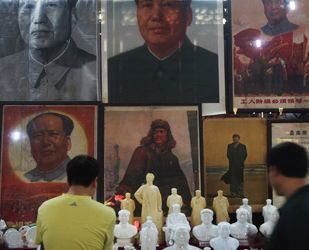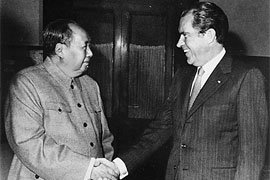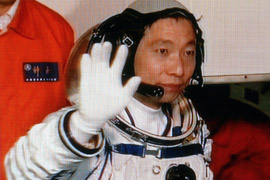China timeline: From Mao to now
Key events from the foundation of the People’s Republic of China to the present day.

1950 – Russia and China form a strategic alliance. Mao begins a massive programme of economic and social reconstruction, but just as the economy shows signs of recovery, China intervenes in the Korean War on the side of North Korea. Chinese forces invade Tibet, which becomes part of the People’s Republic of China.
1958 – Mao launches the “Great Leap Forward”, a five-year economic plan aimed at rapidly raising industrial and agricultural production to catch up with more advanced nations. The results are disastrous. Normal market mechanisms are disrupted, agricultural production plummets, and a nation-wide rush into labour-intensive industry leads to massive inefficiencies and waste.
Disruption to agriculture is blamed for the death by starvation of millions of people.
1959 – An uprising in Tibet against China’s occupation fails and the Dalai Lama, Tibet’s spiritual leader, and 100,000 of his followers flee to India.
The Sino-Soviet split begins as relations with Moscow break down over ideology and leadership of the global communist movement.
 |
| Mao’s ‘little red book’ is one of the most-published works in the world [EPA] |
1960-61 – Two years of famine resulting from the disastrous policies of the Great Leap Forward lead to the deaths of at least 20 million Chinese.
1962 – India and China fight a brief war over their disputed border in the Himalayas.
1964 – China explodes its first atom bomb.
Quotations From Chairman Mao, better known as “the little red book”, is published for the first time.
1965 – Tibet is formally made an autonomous region of China.
1966 – Mao and his wife, Jiang Qing, launch the Great Proliterian Cultural Revolution – an effort to revive revolutionary fervour and purify the party of supposedly “bourgeois” elements. Mao’s Red Guard units, dominated by youths and students, pledge the “destruction of the four olds” (ideas, culture, habits and customs).
Over the next 10 years, tens of thousands suspected of following “the capitalist road” are executed and millions forced into manual labour.
 |
| Nixon’s historic meeting with Mao paved the way for US-China relations |
1971 – The PRC is admitted to the United Nations, taking the seat of the Taiwan-based Republic of China government as a permanent member of the Security Council.
1972 – Richard Nixon makes the first visit to communist China by a US president. The summit ends with both countries declaring a desire to normalise relations.
1976 – The premier, Zhou Enlai, dies in January and Mao’s own health deteriorates. A power struggle is unleashed within the party.
The city of Tangshan is devastated by an earthquake.
Mao’s death on September 9 begins a new era for China. His widow and three of her colleagues – the so-called Gang of Four – are arrested and convicted of crimes against the state.
1977 – Deng Xiaoping emerges as the dominant figure in the leadership. Under him, China embarks on far-reaching economic reforms.
1979 – Beijing and Washington establish full diplomatic relations.
China formally introduces the one-child policy in an effort to slow population growth, seen as a block to economic development.
1986 – China’s “open-door policy” begins, opening the country to foreign investment and encouraging development of a market economy and private sector.
The phrase “to get rich is glorious” is widely attributed to Deng Xiaoping, although it is unclear if he ever actually said it.
1987 – Hu Yaobang, chairman of the Chinese Communist Party and a hero to many reformers, is forced to resign.
1989 – The ideological struggle within the party grows and in May thousands of demonstrators – mostly students and workers – occupy Tiananmen Square in Beijing, calling for democratic reforms.
On June 3 the government orders the military to clear the square. Officially 200 people are killed. Unofficial death tolls put the number nearer to 3,000.
International outrage leads to sanctions against China.
 |
| The Three Gorges Dam is the world’s biggest hydroelectric project [GALLO/GETTY] |
1992 – Russia and China formally end more than 30 years of enmity, signing a declaration restoring friendly ties.
1993 – Jiang Zemin replaces Yang Shangkun as president while hard-liner Li Peng – seen as the main advocate behind the 1989 Tiananmen crackdown – is re-elected to another five-year term as prime minister.
Work begins on the construction of the massive Three Gorges Dam – a project first envisaged by Mao as a way of controlling the annual flooding of the Yangtze and generating electricity.
1995 – China conducts missile tests and military exercises in the Taiwan Strait, apparently to intimidate voters during the island’s presidential elections.
The United States sends two aircraft carrier groups to the region as a show of force to deter any Chinese attack on the island.
1996 – China, Russia, Kazakhstan, Kyrgyzstan and Tajikistan hold a landmark summit in Shanghai. The so-called “Shanghai Five” agree to increase military trust and reduce military forces along their shared borders.
1997 – Deng Xiaoping dies, aged 92, shortly before the handover of Hong Kong from British colonial rule.
1998 – Zhu Rongji succeeds Li Peng as premier, introducing a programme to privatise state-run businesses and further liberalise China’s economy.
1999 – The Falun Gong spritual group is outlawed as a threat to stability.
The Portuguese colonial territory of Macao reverts to Chinese rule, ending five centuries of colonialism in China.
2001 – China joins the World Trade Organisation, ending a 15-year debate over whether it is entitled to the full trading rights of capitalist countries.
China is awarded the hosting of the 2008 Olympic Games.
 |
| Yang Liwei took China into the space age in late 2003 [EPA] |
2002 – Hu Jintao, the vice-president, becomes head of the Communist Party, replacing Jiang Zemin, the outgoing president, and beginning a two-year handover of power. This is seen as transferring the reins to a more technocratic generation of Chinese leaders.
2003 – An outbreak of the previously unknown Sars virus spreads from the southern province of Guangdong. Over the course of the outbreak, 774 people die, mostly in Hong Kong and mainland China.
China becomes only the third country in the world – after Russia and the US – to send a human into space. Yang Liwei orbits the Earth 14 times aboard the Shenzhou V spacecraft.
2005 – Anti-Japanese protests take place in a number of Chinese cities after the publication in Japan of a school textbook said to gloss over its World War II record.
China and Russia hold their first joint military exercises.
2006 – Structural work is completed on the Three Gorges Dam energy and flood control project, the largest in the world. Construction of the dam and its vast reservoir has displaced more than a million people and required the relocation of entire cities.
China-Tibet railway line begins operations – the world’s highest rail service.
2007 – Chinese missile destroys an osolete orbiting Chinese weather satellite in an apparent test of a space weapon. Test draws criticism from several countries and warnings that it risks triggering a space arms race.
A series of product safety scandals raise international alarm about the safety of Chinese exports.
2008 – Anti-China protests erupt in Tibet and spread to Tibetan communities in nearby provinces. The protests are the more serious uprising against Chinese rule in 20 years.
In May a massive earthquake hits the southwestern province of Sichuan, killing at least 70,000 people and leaving thousands more missing.
In August China plays host to the 29th summer Olympic games.